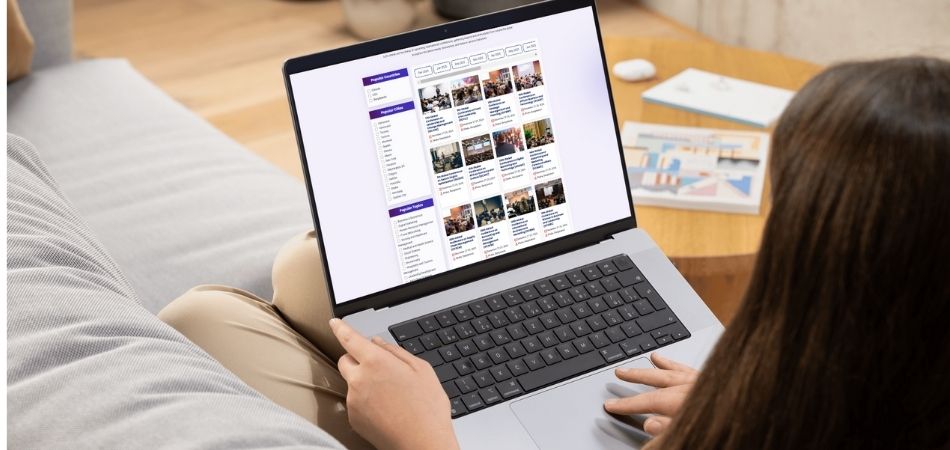You can build credibility and network with professionals in your industry by presenting at a conference. It gives you a platform to showcase your knowledge while gaining visibility among your peers and potential clients. But how to find conferences to present at?
Start by identifying your target audience and researching events in your field. From there, evaluate the quality and credibility of each conference, compare options, and prioritize those that align with your goals. Finally, craft a proposal tailored to the conference’s focus and submission requirements.
To ensure your presentation lands at the perfect conference, we’ll walk you through each step. Check out the full breakdown below!
Why Presenting at a Conference Matters for Career Growth?
Presenting at a conference is a valuable opportunity for professionals to showcase their expertise and gain recognition in their field. It allows individuals to share insights, present research, and engage with peers, enhancing their professional credibility.

Conference presentations also help in building a strong professional network. Engaging with attendees and industry leaders during Q&A sessions or networking breaks can lead to new collaborations, mentorship opportunities, and career advancements. It’s a platform to establish yourself as a thought leader.
International conferences, in particular, offer exposure to a global audience and diverse perspectives. Attending and presenting at upcoming international conferences provides a unique chance to connect with global experts, learn from different cultures, and showcase your work on a broader stage, significantly boosting career prospects.
How to Find Conferences to Present at?
Looking to share your expertise on a bigger stage? Finding the right conference to present at can seem daunting. But with a clear plan, you can identify events that align with your goals. Let’s walk through the steps to help you find the perfect conference opportunity.

Step 1: Identify Your Target Audience
Knowing about who you want to reach is crucial. Think about the professionals or peers who would benefit from your insights. Consider their industry, experience level, and interests. This focus will guide you toward conferences where your presentation will have the most impact.
Step 2: Research Relevant Events in Your Field
Start exploring conferences that serve your target audience. Use industry websites, professional networks, and academic calendars to find upcoming events. Don’t forget to check social media groups and forums for additional leads. Make a list of conferences that catch your eye.
Step 3: Evaluate the Quality and Credibility of Each Conference
Not all conferences are created equal. Look into the history and reputation of each event on your list. Read reviews or ask colleagues about their experiences. Check the lineup of past speakers and attendees to gauge the conference’s prestige. This will help you prioritize the most worthwhile opportunities.
Step 4: Compare and Prioritize Your Options
With your research in hand, start comparing the conferences. Consider factors like location, dates, and costs. Think about which events align best with your professional goals. Prioritize the ones that offer the greatest benefits and fit your schedule.
Step 5: Prepare and Submit Your Proposal
Once you’ve chosen a conference, it’s time to craft your proposal. Customize it to match the event’s theme and submission guidelines. Highlight how your presentation adds value to the conference audience. Proofread carefully before submitting to make a strong first impression.
Finding the right conference to present doesn’t have to be overwhelming. By following these steps and finding conferences for presenting research, you’ll be well on your way to sharing your knowledge with the world. Ready to take the next step? Start your search today and watch your professional network grow!
The Key Elements of Presenting at a Conference
Presenting at a conference is more than just speaking to a crowd. It’s about sharing your insights and connecting with others in your field. To make your presentation impactful, focus on several key elements that can set you apart.
Crafting Clear and Engaging Content
Your content should be clear, concise, and relevant to your topic. Begin by identifying the main message you want to convey. Use stories or examples to illustrate your points and keep the audience interested. Avoid jargon or complex terms that might confuse listeners.
Learning about Your Audience
Knowing who you’re speaking to can greatly improve your presentation. Consider their background, interests, and what they hope to learn. Modify your content to address their needs and expectations. This approach helps build a connection and makes your message more impactful.
Using Effective Visual Aids
Visual aids can upgrade your message when used appropriately. Create slides that are simple, clean, and support your spoken words. Use images or graphics to illustrate complex ideas or data. Avoid overcrowding slides with too much text or unnecessary details.
Managing Your Time Wisely
Respecting the allotted time shows professionalism and courtesy. Plan your presentation to fit within the given timeframe, including time for questions. Rehearse with a timer to ensure you stay on track. Adjust your content if necessary to avoid rushing or running over.
Handling Questions Gracefully
The Q&A session allows for interaction and deeper engagement. Listen carefully to each question before responding thoughtfully. If you don’t know an answer, it’s okay to admit it and offer to follow up later. Being approachable and respectful encourages positive exchanges.
Wrapping up your presentation effectively leaves a lasting impression. Summarize your key points and reinforce the main message. Thank the audience for their time and invite them to connect afterward. Remember, presenting at a conference is an opportunity to share, learn, and grow together.
Can You Learn Anything From Presenting at a Conference?
Yes, absolutely! Presenting at a conference is a learning experience in itself. While you’re sharing your expertise, you’re also gaining new insights, improving your skills, and connecting with others. Let’s explore what you can learn from stepping onto the conference stage.
Improving Communication Skills
Presenting forces you to refine how you convey ideas clearly and effectively. You learn to simplify complex concepts for different audiences. Practicing public speaking builds confidence in delivering your message with clarity. Each presentation improves your ability to engage listeners and hold their attention.
Gaining Feedback on Your Work
Feedback from peers and industry experts is invaluable for growth. Presenting at conferences opens opportunities for constructive criticism and suggestions. You learn what resonates with your audience and what needs improvement. This feedback can refine your ideas and spark new perspectives.
Building Stronger Networks
Presenting helps you connect with like-minded professionals and industry leaders. You gain the chance to exchange ideas and insights with peers. These interactions often lead to long-term collaborations or business partnerships. Building a network strengthens your position in the industry and opens new doors.
Learning Industry Trends
Conferences expose you to the latest developments and trends in your field. You hear firsthand how other experts are approaching challenges and opportunities. This knowledge keeps you up-to-date with industry shifts and innovations. Being aware of these trends helps you stay competitive and informed.
Developing Personal Growth
Presenting pushes you out of your comfort zone and encourages self-development. Each presentation builds your confidence, resilience, and ability to handle pressure. You learn to manage stage fright and sharpen your professional skills. These personal growth benefits extend far beyond the conference room.
Presenting at conferences is more than just sharing what you know—it’s a chance to learn and grow. Take every opportunity to reflect on what you gain from each presentation and apply it to your future endeavors.
Dos and Don’ts in a Conference Presentations
Delivering a great presentation at a conference requires preparation, confidence, and attention to detail. Knowing what to do—and what to avoid—can make all the difference. Here are some essential dos and don’ts to help you present successfully.
Dos:
- Prepare thoroughly by practicing multiple times before the event. This will help you feel comfortable with your material and timing.
- Use simple, clear visuals to support your key points. Avoid overcrowding slides with too much information or unnecessary graphics.
- Engage the audience with eye contact and an approachable tone. This helps to build a connection and keep them interested.
- Structure your presentation logically, with a clear beginning, middle, and end. Make sure each point flows naturally into the next.
- Leave time for audience questions at the end. Be open to feedback and answer questions thoughtfully to encourage positive interaction.
Don’ts:
- Don’t overload your slides with text or data. Too much information on one slide will overwhelm and confuse the audience.
- Avoid reading directly from your slides or notes. This can make your delivery seem robotic and disengaging.
- Don’t speak too fast or too slow during your presentation. Keeping a steady pace helps ensure your audience can follow along comfortably.
- Avoid using overly technical jargon or complex terms. Adjust your language to be clear and accessible to your audience’s level of knowledge.
- Don’t ignore audience cues if they seem lost or disengaged. Pay attention to body language and adjust your presentation style if necessary.
How Do You Select the Right Topic to Present at a Conference?
Choosing the right topic to present at a conference can feel overwhelming, but it’s essential to ensure your presentation is relevant and engaging. Exploring numerous ways to find conferences can help you identify events where your expertise aligns with the audience’s interests. Here’s a step-by-step guide to help you select the perfect topic for your next conference presentation.
Step 1: Identify Your Expertise
Start by reflecting on your strengths and areas of deep knowledge. Think about topics where you can provide valuable insights or unique perspectives. Focus on subjects where you have practical experience or recent findings. This ensures you speak with authority and confidence.
Step 2: Understand the Conference Theme
Each conference has a specific theme or focus that guides the content. Review the event’s call for papers or presentation guidelines to understand what they’re looking for. Choose a topic that directly aligns with the conference’s main themes. This alignment increases the chances of your proposal being accepted.
Step 3: Consider Audience Interests
Think about who will be attending the conference and what their key interests are. Identify the challenges, questions, or trends your audience cares about most. Choose a topic that addresses these concerns or provides new insights. Personalizing your topic for the audience makes your presentation more impactful.
Step 4: Research Recent Industry Trends
Look into the latest developments and emerging trends in your field. Choose a topic that reflects current conversations or addresses a timely issue. This shows your presentation is relevant and forward-thinking. Presenting on a hot topic can also attract more interest from attendees.
Step 5: Evaluate the Relevance and Scope
Make sure your topic is neither too broad nor too niche for the conference. A broad topic can lack focus, while a narrow one may not engage enough people. Choose something that’s relevant to a wide portion of the audience but still allows you to dive deep into specifics. Balancing relevance and depth keeps your presentation compelling.
Tips to Help You Stay Organized During Your Conference Presentation
Staying organized during a conference presentation is key to delivering your message smoothly and confidently. Preparation and structure can help you manage time, stay focused, and keep your audience engaged. Here are some practical tips to ensure you stay on track during your presentation.
- Practice With a Timer: Rehearse your presentation multiple times while timing yourself. This ensures you stay within the allotted time and avoid rushing.
- Organize Your Slides in Logical Order: Structure your slides to follow a clear, easy-to-follow progression. Each slide should naturally lead into the next, avoiding confusion.
- Use Visual Cues on Your Notes: Highlight key points or transitions in your notes to keep you on track. These cues help you move smoothly between sections.
- Keep Your Slides Simple and Focused: Avoid cluttered slides that distract from your message. Use bullet points and visuals to support your ideas, not overwhelm them.
- Manage Your Time Effectively: Divide your presentation into sections with specific time limits. This keeps you aware of the pace and prevents overruns.
- Prepare for Audience Questions: Anticipate potential questions and prepare answers ahead of time. Being ready helps you stay composed and organized during the Q&A session.
FAQs
Finding the right conference to present can be a strategic move for your career or business. Knowing how to get through the process can make all the difference. Here are five frequently asked questions to help you get started.
How Do I Know If a Conference is Worth Attending?
Evaluate the conference by checking past speakers, attendees, and reviews. Ensure the event aligns with your expertise and offers networking opportunities. Look for conferences that attract professionals in your field, offering valuable exposure and credibility.
Where Can I Find Upcoming Conferences in My Industry?
You can find upcoming conferences on industry websites, academic institutions’ event calendars, and social media platforms. Networking with colleagues and joining professional groups or forums can also help you discover relevant events happening locally or globally.
How Early Should I Start Looking for Conferences to Present at?
It’s best to start searching at least six months before the event date. This gives you enough time to prepare your proposal and meet submission deadlines. Early planning also ensures you have more options to choose from.
Should I Consider Virtual Conferences Along With In-person Ones?
Yes, virtual conferences are great for increasing visibility without the cost of travel. They often attract international attendees and provide wider exposure. Plus, virtual events can help you reach more people and expand your professional network.
How Do I Increase My Chances of Getting Accepted to Present?
Customize your proposal to the specific conference’s theme and submission guidelines. Highlight your unique insights and the value you bring to the event. Having a well-structured, clear, and relevant proposal improves your chances of being selected to present.
Bottom Lines
Presenting at conferences can greatly assist your professional journey and open new doors. Finding the right conference involves careful planning, researching events, and focusing on your audience.
So, when you are learning how to find conferences to present at, please make sure you keep in mind to select relevant conferences, evaluate their credibility, and customize your proposals accordingly.
Delivering a strong presentation requires preparation, confidence, and engaging content for your listeners. Stay organized by practicing with a timer and keeping your slides simple and focused. By following these steps, you can maximize the benefits of conference presentations and grow your career.






